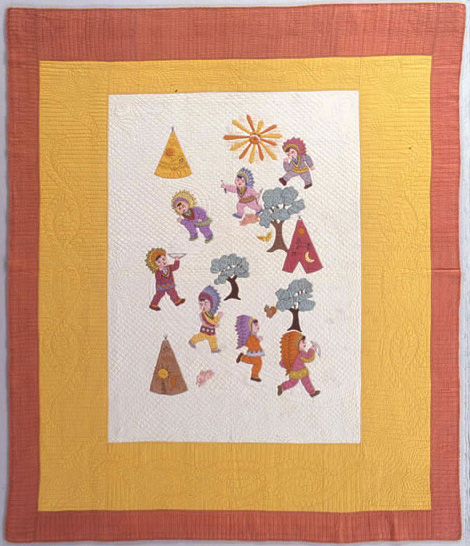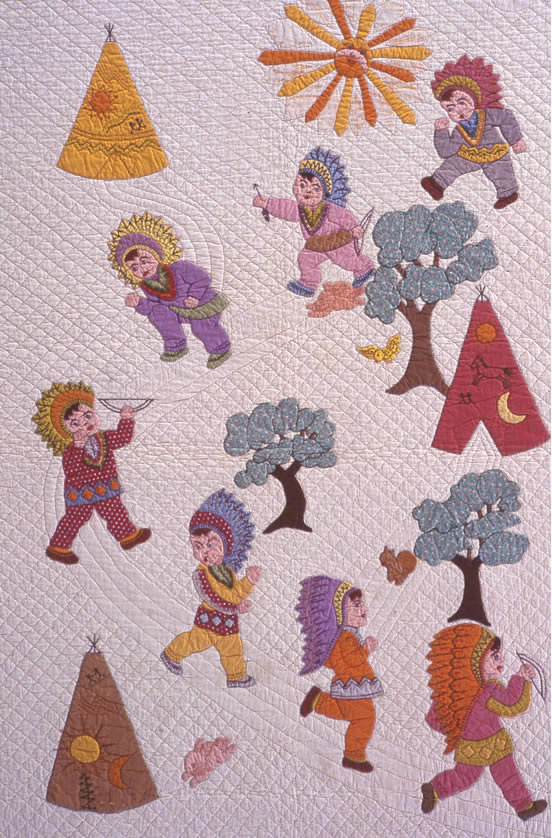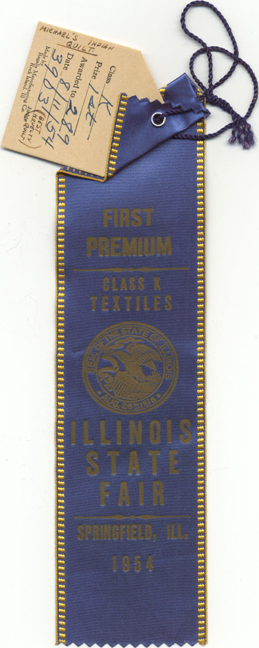
QUILT INDEX RECORD
18-14-69
Description:
In the 1940s, Gasperik made six Indians quilts for her Chicago grandchildren, and another she sent to relatives in Hungary. This one, made for Michael, might have won first prize at the 1954 Illinois State Fair based on a newspaper clipping and a prize with a written notation that Michael's Indian quilt won the commendation.
Where are the records for this quilt housed?
Mary Gasperik Legacy Project
Who documented this quilt?
Mary Gasperik Private Collection
Gasperik Legacy Project Number:
019
This is a:
Finished quilt
Quilt's title:
Indians #4
Owner's name for quilt:
Indians #4 (Michael)
Names for quilt's pattern in common use:
Indian Boys, Seven Little Indians
How wide is the quilt?
66 inches
How long is the quilt?
79 inches
Shape of edge:
Straight
Shape of corners:
Straight
What color is the quilt?
Brown; Gold; Green; Lavender; Orange; Pink; Rust; White
Overall color scheme:
Multicolor; Bright or primary colors
Quilt's condition:
Very good/almost new
What is inscribed on the quilt?
MARY GASPERIK
1411 W. 174th STREEET
EAST HAZELCREST
ILLINOIS
Method used to make the inscription:
Attached label
Location of inscription:
on back
Time period:
1950-1975
When was the quilt finished?
1954
Family/owner's date for quilt:
1954
Who estimated the quilt's date?
Merikay Waldvogel
Further information concerning dates:
The individual Indian Block which accompanied this quilt (#093) is embroidered "Michael 1954"
Describe the quilt's layout:
Medallion or framed center
Subject of the quilt:
Indian Boys At Play
Number of borders:
Two
Describe the borders:
Wide gold border heavily quilted on four sides. Narrower outer rust border on four sides.
Fiber types used to make the quilt top:
Cotton
Fabric styles used in the quilt top:
Print; Solid/plain
Applique techniques used to make the quilt top:
Hand Applique
Embellishment techniques used to make the quilt top:
Embroidery
Materials used to make the back:
Cotton
Materials used in the quilt binding:
Cotton
Fabric structure of the binding:
Plain weave
How is the binding made?
Bias grain
What is the width of the binding (measure on the top only)?
less than a half inch
What kind of filling is used in the quilt?
Cotton
How are the layers held together?
Hand quilting
Color of thread used in the quilting:
white
Quilting designs used, overall motifs:
Grid diamond; Patches outlined/in the ditch; Single parallel lines
Quilting designs used, decorative motifs:
Cables; Feathering; Floral; Other
Quilting designs used, background fills:
Grid/crosshatch; Parallel lines
Describe the quilting designs used:
Rust border filled with square grid quilting. Gold border has Ver Mehren cable feathering along two sides and bottom. Cornucopias spilling fern leaves are quilted into the two upper corners of the gold border. Connecting those cornucopias is a band of connected waves. White ground is diamond cross-hatching with embedded separate patterns including fern leaves from Aunt Martha's Answer #C5573. In the upper corners of the white ground are two nested quilted waves, elaborations of the wave pattern in the gold border. In the lower corners of the white ground are quilted two butterfly-like patterns from an as yet unidentified source. Rounded quilted mounds fill the bottom center of the white ground.
Features or notes about the quilt's appearance, materials, or construction:
Gasperik added another border to this quilt and to #022 and #077, made for Michael's younger brothers.
Quilt top made by:
Gasperik, Mary
Quilted by:
Gasperik, Mary
Where the quilt was made, city:
East Hazelcrest
Where the quilt was made, state:
Illinois (IL)
Where the quilt was made, country:
United States
How was this quilt acquired?
Gift
Why was the quilt made?
Gift or presentation
Details about why the quilt was made:
Presented to a grandchild.
The quilt was made to be used for:
Bedding, special occasion
Quilt is presently used as:
Keepsake/memento
Describe present uses of the quilt:
Mary's grandchildren regard her quilts as a unique collection to be preserved and appreciated.
Where did the maker get their materials?
Purchased new
Where did the maker find their pattern?
Unknown
Where did the quiltmaker find the pattern for the quilting design on the quilt?
Original to maker
What is the commercial name of the quilting design used for this quilt?
Feather corner quilting for all Gasperik Indian Quilts is QB421-9 inch Feather (Colonial Quilts by Hubert Ver Mehren (Des Moines, IA: 1932).
Describe anything about the design of the quilt that wasn't already recorded in a previous field:
Gasperik made framed applique/embroidered Indian Blocks for the same six grandchildren who received the quilts. The block which accompanied this quilt is #093.
Exhibitions where this quilt was displayed:
The Quilts of Mary Gasperik, Ravenswood Historic Site, Livermore, CA, March 14-15, 1992.
Contests entered:
Illinois State Fair, 1954, First Place ribbon, Springfield, IL
Publications (including web sites) where this quilt or maker was featured:
Merikay Waldvogel and Barbara Brackman. Patchwork Souvenirs of the 1933 Chicago World's Fair, (Nashville, TN: Rutledge Hill Press, 1993)102-103.
Merikay Waldvogel "One American Dream Comes True", Quilters Newsletter Magazine, March 2008, 46-49.
Related items such as diaries, obituaries, wills, household inventories, or pictures of the quiltmaker:
Unframed applique block (#093) embroidered "Michael 1954". Elmer Gasperik heirs - contact Kathy Jacob.
The newspaper story (undated, but assumed to beAugust 1954) referring to "first prize for original 'Indian Boys' at the Illinois State Fair. "Mrs. Stephen Gasperik, our local quilting expert, continued her winning ways at the Illinois State Fair this year by winning 2 first & a second prize on her three entries. A first was awarded her "Double Feather Star" design which she copied from a book. It was originally designed in 1835 by a bridegroom for his bride. Another first went to her beautifully original "Indian Boys" which she made for her grandson. A second prize was awarded to her "Dutch Girl" which she made for her granddaughter." (Mary Gasperik archive, private collection)
A blue ribbon "First Premium Class K Textiles Illinois State Fair Springfield, Ill, 1954" with its attached cardboard tag. The attached tag is filled in, in blue ink, as follows: Class: K, Prize: 1st, Awarded to: 289, Date: 8/11/54; and the bottom line is filled in with the numbers 3903, but it isn't clear if this refers to "Made By" or "Judge", both of which are printed below this line. Handwritten by a different person, right next to the number 3903 is the added notation in black ball point pen "(best novelty quilt)" and at the far left of the tag is added (in the same hand) the words "Michael's Indian Quilt" (in collection of Kathy Jacob).
In an e-mail to Susan Salser (January 11, 2009) Elmer and Doris Gasperik’s daughter Kathy Jacob described to Susan her parents’ support of Mary Gasperik’s quilting and the appreciation for the quilts which they instilled in her. She wrote: “I know that my Mother took great care of our quilts. Dedicated to them as if her own mother had made them. It is from my mother that I learned to lovingly care for the quilts and appreciate the work that grandma had done. And I was told that my father made her the very quilting frame that she used to create these wonderful quilts. I was also told he would buy her batting and once a children’s book for the pictures perhaps for reference.” A children’s book illustration is possibly the genesis of this Gasperik quilt design.
Ownership of this quilt is:
Private
Quilt owner's name:
Elmer Gasperik Heirs - contact Kathy Jacob
Quilt owner's country:
United States
Person filling out this form is:
Relative of quiltmaker; Author/researcher
If you are a relative of the quiltmaker, how are you related? The quiltmaker is my:
Grandmother
Describe the relationship to the quilt's maker:
Grand-daughter Susan Salser began this research effort in 1991, after she and her two sisters divided up the quilts which belonged to their mother (Elsie Gasperik Krueger) who died in 1988. Her ongoing research has been fruitful and interesting.
Quiltmaker's maiden name:
Mihalovits, Maria
Quiltmaker's gender:
Female
Quiltmaker's birth date:
01/25/1888
Quiltmaker's birthplace, country:
Hungary
Quiltmaker's date of death:
05/25/1969
Quiltmaker's ethnic background/tribal affiliation:
Hungarian
Quiltmaker's educational background:
Elementary School
In which kind of environment did the quiltmaker live?
Rural
Quiltmaker's city:
Chicago
Quiltmaker's county:
Cook
Quiltmaker's state:
Illinois (IL)
Quiltmaker's country:
United States
Quiltmaker's father's name:
Mihalovits, Istvan
Quiltmaker's father's birthplace:
Hungary
Quiltmaker's father's ethnic/tribal background:
Hungarian
Quiltmaker's mother's name:
Mihalovits, Vidoszava
Quiltmaker's mother's birthplace:
Hungary
Quiltmaker's mother's ethnic/tribal background:
Hungarian
Quiltmaker's spouse's/spouses' and/or partner's/partners' ethnic/tribal background:
Hungarian
Quiltmaker's spouse's/spouses' and/or partner's/partners' occupation:
Milk Dealer/Grocery Store Owner/Butcher
Number of children:
3
How many of the quiltmaker's children were girls?
1 (Elsie 1909-1988)
How many of the quiltmaker's children were boys?
2 (Elmer and Stephen)
How did the quiltmaker learn to quilt?
From guild or club member; Self-Taught
When did the quiltmaker learn to quilt?
Age 40-49
Why does the quiltmaker quilt?
Pleasure; Other
Other notes on how the quiltmaker learned, and how and why they quilt:
To exhibit in shows held by her Tuley Park quilt club in Chicago, the Detroit News quilt show in Detroit, many Illinois State Fairs, at least one Indiana State Fair. She entered quilts in at least 2 Chicago department store contests. She made at least one quilt and one quilt top specifically for the 1939 New York Worlds Fair quilt contest. She also made children's quilts specifically for grandchildren and great-grandchildren; and wedding and wedding anniversary quilts for her son Elmer and grand-daughter Karen. Primarily, she wanted to make quilts because it was her life passion and her greatest talent. The occasions and venues to show them presented themselves. It should be noted that prior to Mary's emigration to America in late 1904, at age 16, she was an apprenticed needleworker in her native Hungary. The intricate and colorful floral embroideries traditional to Hungary lend themselves especially well to applique, the quilt style Mary preferred.
Does/did the quiltmaker belong to a group? Name of the group?
Tuley Park Quilt Club and Detroit News Quilt Club
Does/did the quiltmaker belong to a group?
Chicago, IL and Detroit, MI
What are the main activities of the group?
Chicago group met to quilt and held periodic quilt show; Detroit group held national exhibits and contests.
Estimated number of quilts made by this quiltmaker:
more than 50
Does/did the quiltmaker sell quilts?
no
Does/did the quiltmaker teach quilting?
no
Who photographed this quilt?
Don Gonzalez
Access and copyright information:
Restricted
Copyright holder:
Susan Salser
Details
Cite this Quilt
Gasperik, Mar. Indians #4. 1954. From Mary Gasperik Legacy Project, Mary Gasperik Private Collection. Published in The Quilt Index, https://quiltindex.org/view/?type=fullrec&kid=18-14-69. Accessed: 04/19/24
-
Gallery
Gasperik 05: Gifts for Children
Waldvogel, Merikay
-
Exhibit
The Quilts of Mary Gasperik
Salser, Susan
-
Ephemera
The Quilts of Mary Gasperik
Salser, Susan
-
Essay
Mary Gasperik and The Illinois State F...
Salser, Susan
-
Ephemera
Mrs. Stephen Gasperik…
Chicago area newspaper
-
Gasperik, Mary Quiltmaker
Mary Gasperik Legacy Project
-
1954
Indian Block Gasperik, Mary

